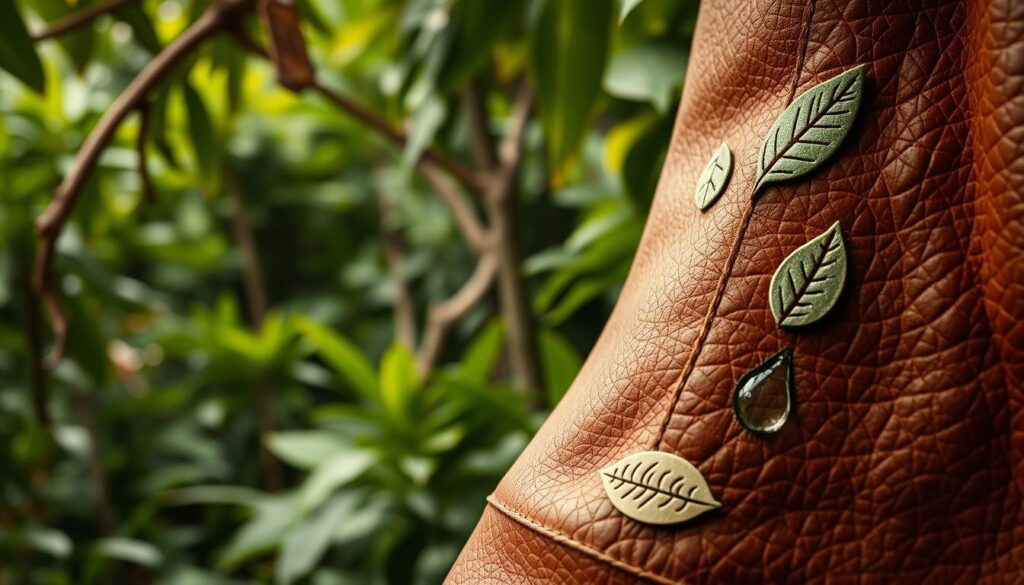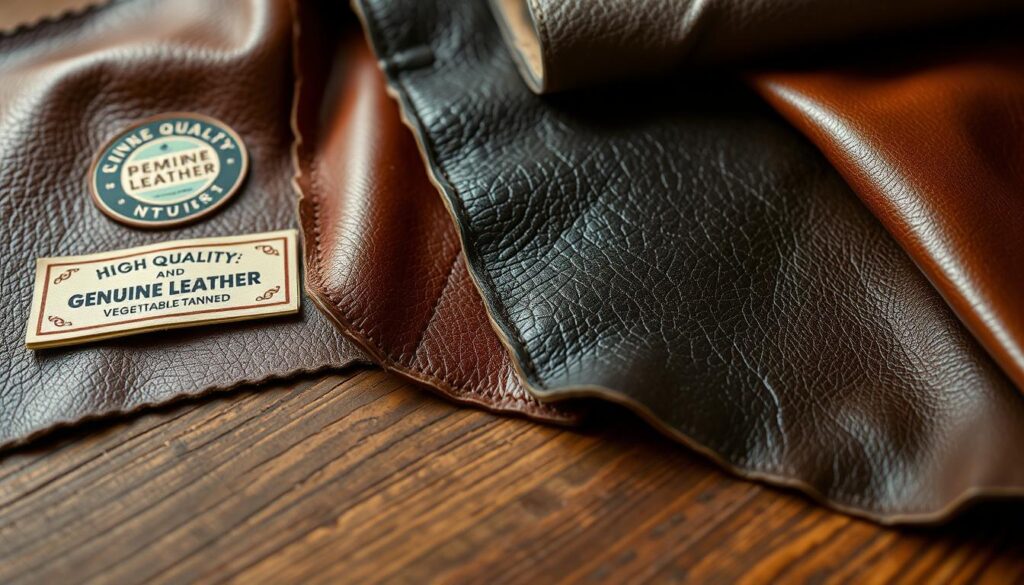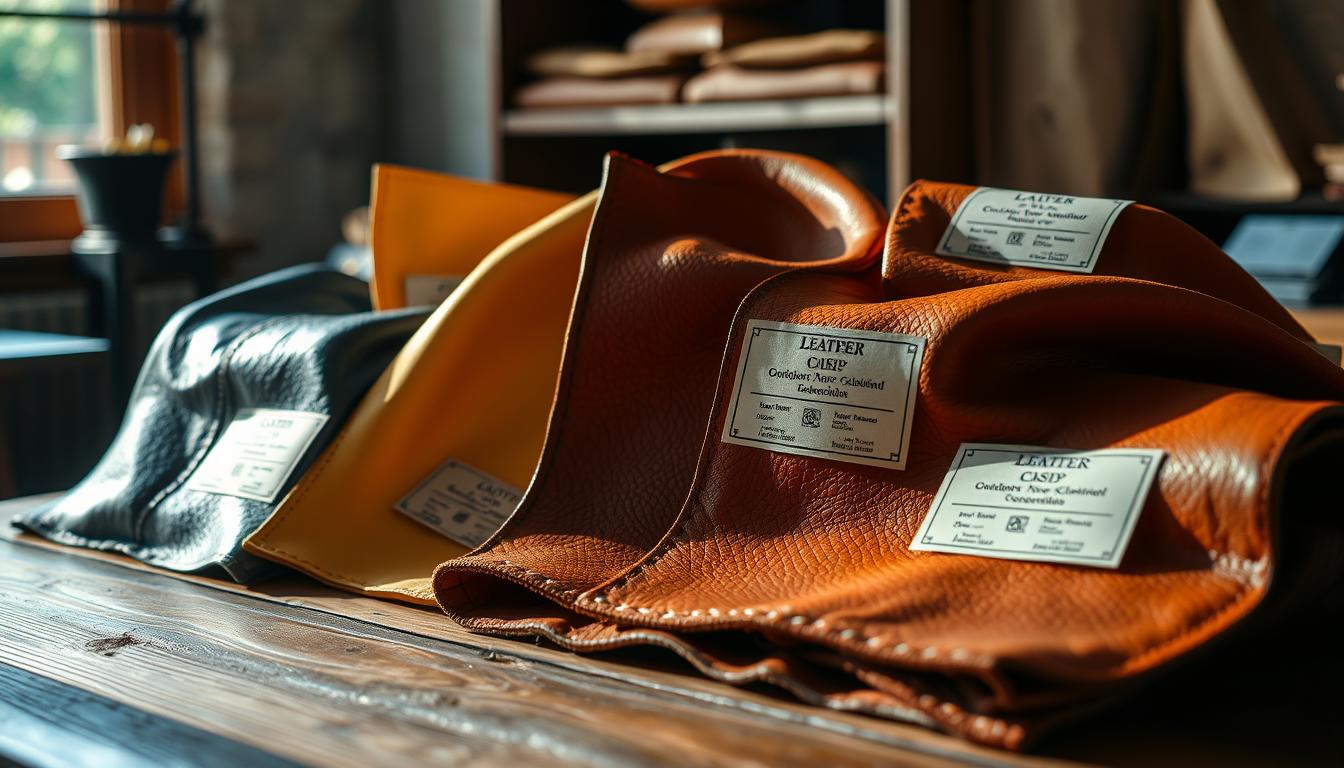Many people wonder how to know if leather is good quality and made right. It’s hard to tell because labels can be confusing. Terms like “synthetic leather” or “vegan leather” might not mean what you think.
But, there’s a way to be sure. Look for Leather Quality Standards and Sustainable Leather Certifications. They help you find real, high-quality, and made-right leather.
Key Takeaways
- Leather Quality Standards ensure product authenticity and sustainability
- Leather Working Group (LWG) assesses environmental compliance
- OEKO-TEX® Leather Standard tests for harmful substances
- Sustainable Leather Foundation uses a Transparency Dashboard™
- ISO 14001 and 9001 set international standards for leather production
Understanding the Importance of Leather Certifications
Leather certifications are very important. They help keep quality and sustainability high. They also make sure products are safe and made ethically.
Ensuring Quality and Sustainability
Standards like DIN are key for checking leather quality. DIN 53333 checks strength, and DIN 53336 looks at how it looks. These help us know what we’re buying.
Meeting Consumer Demands for Ethical Products
People now want products made the right way. Labels like “bluesign” and “OEKO-TEX Standard 100” show leather is made well. The “Blue Angel” label means the leather is good for the planet.
Navigating the Labeling Jungle
It’s hard to know what leather labels mean. Full grain is the best, while genuine is not as good. Real leather doesn’t always mean it’s quality. Certifications help us know what we’re buying.
| Leather Type | Quality | Common Uses |
|---|---|---|
| Full Grain | Highest | High-end briefcases, travel bags |
| Top Grain | High | Lower-end bags, wallets, belts |
| Genuine | Low | Budget leather goods |
| Bonded | Lowest | Inexpensive leather products |
Certifications like the Leather Working Group help make leather production better. They make sure leather is made right and is good for the planet. This meets the need for ethical, quality leather.
Leather Working Group (LWG) Certification
I’ve found out that the Leather Working Group (LWG) Certification is key for green practices in the leather world. It started in 2005 and now tackles big environmental and social issues in leather making.
The LWG checks 17 important parts of leather making. These include how waste is handled, water use, energy use, and how chemicals are used. In 2021, it added checks for environmental, social, and governance (ESG) stuff too.
One cool thing about LWG is its tiered system:
- Gold: 85% or higher compliance
- Silver: 75% or higher compliance
- Bronze: 65% or higher compliance
This system pushes for better green practices. Bronze level shows a big step towards eco-friendly making.
The LWG also wants things clear. Since 2023, factories must share how much energy and water they use for each job. This is key for better green leather and testing.
Many fashion brands are choosing LWG-certified leather. For example, Sarah Flint wants to use only LWG-certified leather by 2026. This shows more people want green leather goods.
| Year | LWG Milestone |
|---|---|
| 2005 | LWG Established |
| 2021 | Expanded to include ESG metrics |
| 2023 | Detailed consumption reporting required |
| 2030 | Goal to eliminate deforestation from certified supply chains |
Institute of Quality Certification for the Leather Sector (ICEC)
I’ve found out that ICEC is key in setting Leather Quality Standards. This group, supported by UNIC Italy, gives leather makers important tools. Their Code of Conduct and Social Accountability sets out key rules for ethical business.
Code of Conduct and Social Accountability
ICEC’s Code of Conduct is a big deal for the leather world. It gives clear rules for makers to follow. This ensures fair work and green production, meeting consumer wants for ethical goods.
Environmental Sustainability Certifications
ICEC really cares about Sustainable Leather Certifications. They have a special eco-leathers certification for green leather making. This is key as new green rules come in.
For instance, from January 2025, the European Anti-Deforestation Regulation will ban products causing deforestation. ICEC’s certifications help makers stay on top of these rules. They also work with LWG to check tanneries’ green efforts.
Many tanneries have several ICEC certifications. This shows they really care about quality and the planet. As a buyer, looking for these certifications means you’re getting top-notch, eco-friendly leather.
Brazilian Leather Certification of Sustainability (CSCB)
I’ve found something exciting in Sustainable Leather Certifications: the Brazilian Leather Certification of Sustainability (CSCB). It’s changing the leather world by pushing for better practices and clear Leather Sourcing Transparency.
The CSCB has a special way of looking at sustainability. It focuses on three main things:
- Economic viability
- Environmental protection
- Social responsibility
This wide view makes sure companies make great leather. They also help their communities and the planet.

Brazilian leather makers are getting on board with this certification. For example, JBS, a big leather company, follows CSCB standards.
The CSCB is making a big difference. It meets the need for clear product sources and environmental effects. Many people now choose products based on these things.
| Aspect | CSCB Impact |
|---|---|
| Economic | Improved efficiency and market access |
| Environmental | Reduced waste and resource consumption |
| Social | Better working conditions and community support |
By picking CSCB-certified leather, buyers support green practices in Brazil. This certification is a big leap towards clear Leather Sourcing Transparency and eco-friendly making.
LEATHER STANDARD by OEKO-TEX®
I’ve found that LEATHER STANDARD by OEKO-TEX® is a big deal in the leather world. It’s a global system that makes sure products are safe and high-quality. It’s great for those who care about quality and the planet.
Testing and Certification System
The OEKO-TEX® certification is very detailed. It checks every part of making leather products, including what’s used in them. It goes beyond what countries or groups say is safe, making it a top choice for leather standards.
- Tests for banned substances like Azo colourants, chromium (VI), formaldehyde, and more
- Annual updates based on latest scientific findings
- Certification available for brands, retailers, and manufacturers
Human-Ecological Product Safety
OEKO-TEX® focuses on keeping people and the planet safe from leather products. It tests over 1,000 harmful substances. This means every part of a certified item, from threads to buttons, is very safe.
| Certification Benefits | Impact |
|---|---|
| Global Recognition | Enhances product credibility worldwide |
| Consumer Trust | Assures highest product safety |
| Compliance Support | Assists with REACH and other regulations |
| Quality Assurance | Regular checks maintain high standards |
More than 35,000 companies worldwide have chosen OEKO-TEX® standards. This shows how important this certification is for the future of leather quality and care for the planet.
Sustainable Leather Foundation (SLF) Certification
I’ve found that the Sustainable Leather Foundation (SLF) has a great way to certify leather. They work from the start to the end of leather making. They check if leather is made right, good for the planet, fair to workers, and follows rules.
The SLF Transparency Dashboard™ really stands out. It shows how well a company does in being green. It’s great for both makers and buyers who want to choose eco-friendly leather.
SLF uses QR codes in their certification. This lets people see where their leather comes from. It’s a big step towards being open about how leather is made.
The Gold Rated SLF Certification is special. It shows a company is really good at being green and fair. It means they lead in making leather the right way.
| SLF Certification Aspects | Benefits |
|---|---|
| Environmental Compliance | Reduced ecological footprint |
| Social Compliance | Improved worker conditions |
| Governance Compliance | Enhanced business ethics |
| Traceability | Increased supply chain transparency |
Zero Discharge of Hazardous Chemicals (ZDHC)
I’ve been looking into eco-friendly leather options and how leather is made. I’m excited to share what I’ve found about ZDHC. This group is changing the fashion world for the better.
Reducing Chemical Discharge
ZDHC wants to get rid of harmful chemicals in fashion. They aim to make all chemical use safe by 2030. They also hope to get 70% of the industry to follow their rules.
Promoting Better Chemistry
Over 320 companies have joined ZDHC. They’re working to make fashion safer. They want to change how we make things.
ZDHC is doing more than just cleaning up chemicals. They’re also helping with air pollution. They showed their work in Brazil at FEBRATEX 2024. This shows how leather making can get better everywhere.
Following ZDHC rules is good for the planet and for business. It makes companies look better and work more efficiently. As people want more green leather, ZDHC is leading the way to a greener fashion future.
Certifications for High-Quality Leather
Leather Quality Standards are key for top leather products. The IVN Natural Leather Standard is a great example. It bans harmful stuff like chromium salts and glyoxal in leather making.
Leather Grading Certifications, like the IVN, check the whole process. They make sure everything is done right, from start to finish. They do on-site checks and test for quality.

Products that pass get a “Natural Leather IVN certified” label. This is like the Global Organic Textile Standard (GOTS) for leather. It’s great to see big groups working with IVN to make more natural leather available.
Now, let’s see what’s good about certified leather:
| Aspect | Benefit |
|---|---|
| Water Usage | 20% less water used |
| Energy Consumption | 30% less energy consumed |
| Chemical Usage | Up to 50% fewer chemicals used |
| Carbon Emissions | 70-80% lower than genuine leather |
| Durability | 1.5 to 2 times longer-lasting |
Certifications mean quality and care for the planet. Certified leather is better for the environment and still top-notch.
ISO 14001: Environmental Management Systems
I’ve seen how ISO 14001 changes things for Sustainable Leather Certifications. It’s a global standard for managing the environment in Leather Manufacturing Processes.
Framework for Environmental Performance
ISO 14001 gives leather companies a strong base for being eco-friendly. It helps them measure and better their environmental footprint. They make sure to follow rules and reach their green goals.
Benefits of ISO 14001 Certification
ISO 14001 certification is a big win for leather makers. It shows they care about the planet, which can make them more respected. It also can save them money by making things more efficient.
| Benefit | Impact |
|---|---|
| Environmental Performance | 87.8% traceability in Leather Working Group GOLD certification |
| Regulatory Compliance | Adherence to REACH Regulation for all products |
| Reputation Enhancement | Adoption of Code of Ethics for transparency |
| Continuous Improvement | Implementation of PDCA cycle in management systems |
ISO 14001 certification, along with LWG Gold Medal and UNIC Social Accountability, makes a strong plan for green leather making. It covers important areas like chemicals, energy, and waste. This helps leather companies meet the need for eco-friendly goods.
ISO 9001: Quality Management Systems
ISO 9001 is a big deal in the world of Leather Quality Standards. It’s not just a fancy badge. It’s a promise of top-notch quality. For companies dealing with leather, it’s like having a seal of approval that says, “We’re serious about our craft.”
What’s cool about ISO 9001 is how it spreads across the globe. Over a million companies in more than 170 countries have this certification. That’s huge! It’s not just for big players either. Take CGI International, for example. They’ve been in the leather restoration game for 40+ years and recently got their ISO 9001 badge. It’s a real game-changer for them.
Now, let’s talk about what this means for leather lovers like us. When a company has ISO 9001, it’s basically saying they’ve got their act together. They’re following strict rules to make sure their leather products are top-notch every single time. It’s not just about the end product either. The whole process, from start to finish, is under the microscope. For Leather Grading Certifications, this is gold.
The best part? This certification isn’t a one-and-done deal. Companies have to keep proving they’re up to snuff. They do internal checks regularly, and every three years, an outside expert comes in to make sure everything’s still on track. It’s like a constant push to be better. So, when you’re shopping for leather goods, keep an eye out for that ISO 9001 stamp. It’s your ticket to quality you can trust.
